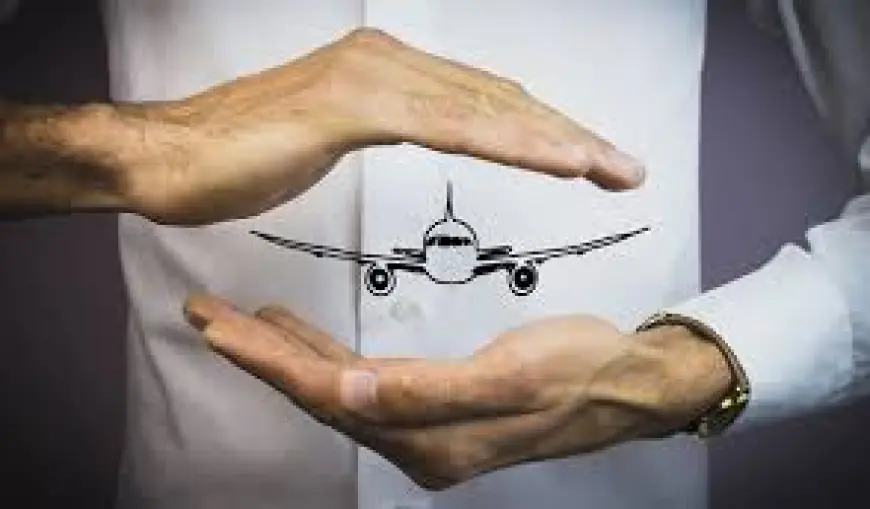Aviation Insurance Market 2029 Emerging Growth Segments
The market is influenced by several factors, including the overall health of the aviation industry, regulatory changes, and technological advancements.

Introduction
The Global Aviation Insurance Market is an indispensable pillar of the aviation industry, offering specialized risk management solutions to safeguard aircraft operators, passengers, and aviation-related assets. In 2023, the market stood at an estimated value of USD 4.29 billion, and according to market projections, it is anticipated to grow at a CAGR of 5.27% between 2025 and 2029.
Aviation insurance is not just another niche insurance category — it is the backbone that enables the seamless functioning of global air transport by mitigating risks associated with aircraft operations. From traditional perils like accidents, mid-air collisions, and hull damage to modern-day challenges such as cyberattacks on flight systems, the scope of aviation insurance continues to expand in response to a rapidly evolving industry landscape.
The modern aviation ecosystem is a complex network that connects airlines, private aviation companies, maintenance providers, and regulators across continents. In such an interconnected environment, insurance is not merely a legal requirement but a strategic necessity, ensuring operational stability and fostering industry confidence.
Market Overview
The aviation insurance market serves a dual purpose — it provides comprehensive coverage for a wide range of risks while also evolving to address the challenges posed by modern aviation operations.
Key coverage categories include:
- Public Liability Insurance – for damage to third-party property or injuries.
- Passenger Liability Insurance – for injury or death of passengers.
- Hull Insurance – for damage or loss of the aircraft itself.
- Combined Single Limit (CSL) policies – offering flexible combined coverage.
- In-Flight Insurance – covering incidents during operation.
These offerings cater to a variety of stakeholders, including commercial airlines, private jet owners, helicopter operators, charter companies, and cargo airlines.
The market’s expansion is being driven by:
- Rising global air passenger traffic.
- Increasing fleet sizes of commercial and private aircraft.
- Regulatory mandates for minimum insurance requirements.
- Technological developments in avionics and flight systems.
Download Free Sample Report: https://www.techsciresearch.com/sample-report.aspx?cid=23474
Emerging Trends in the Global Aviation Insurance Market
1. Rise of Cyber Risk Coverage in Aviation Policies
With the integration of advanced avionics, AI-based navigation systems, and connected flight management systems, cyber threats have emerged as a significant concern. Cyber insurance is becoming a critical add-on, offering protection against system hacking, data breaches, and disruptions to flight operations.
2. Tailored Policies for General & Business Aviation
General & Business Aviation — encompassing corporate jets, helicopters, and private planes — is experiencing robust growth. This segment requires specialized policies to address unique risk factors, such as higher per-flight liability and bespoke asset coverage for luxury aircraft.
3. Integration of Predictive Analytics in Risk Assessment
Insurers are increasingly using predictive analytics to model accident probabilities, maintenance-related incidents, and weather-related risks. This data-driven approach improves pricing accuracy and helps in developing personalized coverage plans.
4. Expansion of Drone and Unmanned Aerial Vehicle (UAV) Insurance
As UAV usage increases for cargo delivery, surveillance, and agriculture, aviation insurers are expanding their portfolios to include comprehensive drone insurance policies that cover collision damage, theft, and liability.
5. Demand for Green Aviation Insurance Products
With the aviation sector focusing on sustainability and the adoption of low-emission aircraft, insurers are introducing eco-friendly policies that incentivize the use of fuel-efficient and environmentally responsible aviation technologies.
Market Drivers
1. Technological Advancements in Aviation
The continuous evolution of aircraft systems — including autonomous flight technologies, digital cockpit systems, and advanced navigation tools — has increased both operational efficiency and complexity. These advancements necessitate specialized insurance policies that can address the risks of technological failures and cyber interference.
2. Regulatory Mandates and Compliance Standards
National and international aviation authorities require airlines and aircraft operators to maintain specific insurance levels for operational licensing. This legal framework ensures steady demand for aviation insurance products covering hull damage, passenger liabilities, and third-party risks.
3. Globalization of Aviation Routes
Airlines are increasingly operating across continents, connecting more destinations than ever before. This expansion into diverse regulatory and environmental conditions increases exposure to geopolitical risks, extreme weather events, and operational hazards — all of which boost demand for comprehensive, multi-jurisdictional insurance policies.
4. Growth in Private and Corporate Air Travel
High-net-worth individuals and corporations are driving the demand for private jets and chartered flights. This has opened lucrative opportunities for insurers offering specialized coverage for luxury aircraft, crew liability, and high-value cargo.
5. Rising Aviation Traffic and Fleet Expansion
Post-pandemic recovery has led to a surge in passenger numbers and fleet modernization initiatives. Airlines are purchasing next-generation aircraft, and each acquisition fuels the need for adequate insurance coverage.
Industry Key Highlights
- Market Size 2023: USD 4.29 billion.
- Forecast CAGR (2025–2029): 5.27%.
- Key Coverage Types: Hull insurance, passenger liability, public liability, CSL, and in-flight insurance.
- Key Applications: Commercial aviation, general & business aviation, and others.
- Growth Segments: Strong demand for business aviation coverage and cyber risk protection.
- Drivers: Technological innovation, fleet expansion, regulatory requirements, globalization.
- Challenges: High competition, evolving risk landscape, global uncertainties.
Competitive Analysis
The global aviation insurance market is highly competitive, with both global leaders and specialized niche players striving for market share. Competition is driven by product innovation, pricing strategies, and the ability to provide tailored solutions for diverse aviation segments.
Major Players Include:
- Allianz SE – A leading provider offering comprehensive aviation risk solutions worldwide.
- AXA SA – Known for innovative insurance products and competitive global coverage.
- American International Group Inc. (AIG) – Offers both traditional and cyber risk aviation coverage.
- Chubb Limited – Specializes in high-value aircraft and complex aviation risk portfolios.
- USAA Inc. – Strong in private aviation and specialized client groups.
- Marsh LLC – A major broker providing custom aviation insurance solutions.
- Aon plc – Known for risk consulting and large-scale aviation insurance packages.
- Great American Insurance Company – Focuses on niche aviation markets and business aviation.
- AIG Aerospace Insurance Services Inc. – Expertise in technical aviation risk assessment.
- Avion Express Insurance – Offers specialized aviation coverage with a focus on operational safety.
Insurers differentiate themselves by offering value-added services such as real-time risk monitoring, claims management support, and global network assistance for cross-border incidents.
Future Outlook
The global aviation insurance market is set for steady growth through 2029, driven by a combination of technological adoption, regulatory enforcement, and increasing global connectivity. The future will witness:
- Greater Adoption of AI and Blockchain in Insurance Processes – enabling faster claims processing and enhanced transparency.
- Integration of Climate Risk Coverage – responding to the increasing frequency of extreme weather events.
- Expansion into Emerging Markets – especially in Asia-Pacific, where air travel demand is surging.
- Collaborations Between Insurers and Aviation Tech Firms – to create highly customized and predictive coverage solutions.
- Evolution of Pricing Models – from fixed annual premiums to usage-based insurance in certain aviation segments.
By 2029, the market will likely be defined by insurers that can balance competitive pricing with comprehensive, technology-driven risk coverage.
10 Benefits of the Research Report
- Comprehensive Market Overview – Understand the global aviation insurance industry landscape and its key components.
- Accurate Market Forecasting – Reliable data projections for strategic planning.
- Emerging Trends Identification – Stay ahead with insights on upcoming developments.
- Detailed Segmentation – Analysis by type, application, and region for targeted strategies.
- Competitive Benchmarking – Evaluate market leaders and their strategies.
- Risk & Opportunity Analysis – Identify potential growth areas and associated challenges.
- Regulatory Insight – Understand the legal framework influencing the market.
- Investment Feasibility – Make informed investment and expansion decisions.
- Technological Impact Assessment – Evaluate how tech advancements shape the market.
- Customized Insights – Tailored recommendations for specific business needs.
Conclusion
The Global Aviation Insurance Market plays a pivotal role in enabling safe, sustainable, and globally interconnected air travel. As the aviation sector evolves, the scope of risks expands, demanding more innovative and adaptable insurance solutions. Technological progress, globalization, regulatory standards, and the surge in business aviation are driving consistent market growth.
Insurers that can balance comprehensive coverage, competitive pricing, and rapid adaptation to new risks will lead the market by 2029. While challenges like geopolitical uncertainty, catastrophic events, and emerging cyber threats persist, the industry’s resilience lies in its ability to innovate and provide tailored solutions that safeguard the interests of all aviation stakeholders worldwide.
Contact Us-
Mr. Ken Mathews
708 Third Avenue,
Manhattan, NY,
New York – 10017
Tel: +1-646-360-1656
Email: [email protected]
Website: www.techsciresearch.com
What's Your Reaction?
 Like
0
Like
0
 Dislike
0
Dislike
0
 Love
0
Love
0
 Funny
0
Funny
0
 Angry
0
Angry
0
 Sad
0
Sad
0
 Wow
0
Wow
0


















































